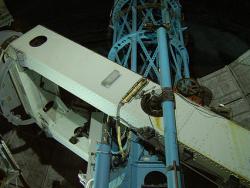The increased light-grasp of this telescope made possible many notable advances in structural cosmology between 1924 and 1930, which have revised our ideas about the universe. One of these advances was that spiral nebulae are galactic units like our own; another was the idea of an expanding universe. George Ellery Hale began planning this project in 1906; Francis G. Pease was the chief designer and mechanical engineer. The telescope's mirror support and the use of mercury flotation to reduce the friction are among its outstanding mechanical engineering features.
Mercury Flotation

YearAdded:
Image Credit: Courtesy Flickr/Bruce Irving (CC BY 2.0)Image Caption: Mount Wilson Observatory, 100-inch Hooker TelescopeEra_date_from: 1918
1981
Innovations

The increased light-grasp of this telescope made possible many notable advances in structural cosmology between 1924 and 1930, which have revised our ideas about the universe. One of these advances was that spiral nebulae are galactic units like our own; another was the idea of an expanding… Read More


